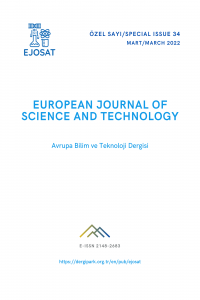Abstract
Karbon nanofiberler (KNF'ler), KNF'lerin yüksek elektronik iletkenliği ve kimyasal stabilitesi nedeniyle sensörler, enerji depolama ve biyomedikal uygulamalar gibi birçok uygulamada kullanılmıştır. Karbon nanoliflerin performansı, nanoliflerin fiziksel ve kimyasal özelliklerinden etkilenir. Ayrıca, morfoloji, gözeneklilik ve spesifik yüzey alanı, enerji depolama ve sensörler dahil olmak üzere çeşitli uygulamalar için önemli özelliklerdir. Kimyasal buhar biriktirme, katalitik sentez, ark deşarjı ve elektro eğirme dahil olmak üzere nanolifler üretmek için çeşitli teknikler vardır. Yüzey alanını ve gözenekliliği kontrol etmek, KNF'lerin performansı göz önüne alındığında hayati önem taşır. Bu çalışmada, yaygın olarak kullanılan iki nanolif üretim tekniği ile poliakrilonitril (PAN) nanolifleri üretilmiştir; elektro eğirme ve santrifüj eğirme. Polimerik nanoliflerin morfolojisi SEM kullanılarak incelenmiştir. Ayrıca, karbon nanofiberleri ve gözenekli karbon nanofiberleri üretmek için havada ve azot atmosferde ısıl işlem uygulandı. Üretim tekniğinin morfoloji ve kimyasal yapıya etkisi SEM ve XRD çalışmaları ile araştırılmıştır. Elektrospun PAN/PS nanolifleri, eğirme çözeltisinin düşük viskozitesi nedeniyle sicim morfolojisi üzerinde boncuklar gösterirken, santrifüj eğirme tekniği kullanılarak hatasız homojen lifler elde edildi. Santrifüjle eğrilmiş PAN nanolifler pürüzlü bir yüzeye sahipken, elektroeğirme tekniği kullanılarak pürüzsüz yüzeyli PAN nanolifler elde edilmiştir. Santrifüjleüretilmiş PAN/PMMA nanoliflerinden türetilen PCNF'ler, gözenekli yapıya sahip pürüzlü bir yüzeye sahipti ve XRD analizi, PCNF'lerin amorf yapısını kanıtladı.
Keywords
References
- Kim, J., Heo, Y.-J., Hong, J.-Y., & Kim, S.-K. J. M. (2020). Preparation of porous carbon nanofibers with tailored porosity for electrochemical capacitor electrodes. 13(3), 729.
- Lee, G., Kim, K. J., Yu, W.-R., & Youk, J. H. J. I. j. o. n. (2013). The effect of the surface roughness of carbon fibres on CNT growth by floating-catalyst chemical vapour deposition. 10(8/9), 800-810.
- Liu, T., Gu, S.-y., Zhang, Y.-h., & Ren, J. J. J. o. P. R. (2012). Fabrication and characterization of carbon nanofibers with a multiple tubular porous structure via electrospinning. 19(6), 1-6.
- Rihova, M., Ince, A. E., Cicmancova, V., Hromadko, L., Castkova, K., Pavlinak, D., . . . Macak, J. M. (2021). Water‐born 3D nanofiber mats using cost‐effective centrifugal spinning: comparison with electrospinning process: a complex study. Journal of Applied Polymer Science, 138(5), 49975.
- Sharma, C. S., Vasita, R., Upadhyay, D. K., Sharma, A., Katti, D. S., Venkataraghavan, R. J. I., & Research, E. C. (2010). Photoresist derived electrospun carbon nanofibers with tunable morphology and surface properties. 49(6), 2731-2739.
- Wang, M.-x., Guo, Z.-y., Huang, Z.-h., & Kang, F.-y. J. N. C. M. (2016). Preparation of porous carbon nanofibers with controllable pore structures for low-concentration NO removal at room temperature. 31(3), 277-286.
- Yadav, D., Amini, F., & Ehrmann, A. (2020). Recent advances in carbon nanofibers and their applications–a review. European Polymer Journal, 138, 109963.
Abstract
Carbon nanofibers (CNFs) have been used in many applications such as sensors, energy storage and biomedical applications owing to high electronic conductivity and chemical stability of CNFs. Performance of carbon nanofibers are influenced by the physical and chemical properties of nanofibers. Furthermore, morphology, porosity and specific surface area are important properties for several applications including energy storage and sensors. There are several techniques to produce nanofibers including chemical vapor deposition, catalytic synthesis, arc discharge and electrospinning. Controlling surface area and porosity is vital considering the performance of CNFs. In this study, polyacrylonitrile (PAN) nanofibers were produced via two commonly used nanofiber production techniques; electrospinning and centrifugal spinning. The morphology of the polymeric nanofibers was studied by using SEM. Moreover, heat treatment was applied in air and the inert atmosphere to fabricate carbon nanofibers and porous carbon nanofibers. The effect of production technique on the morphology and chemical structure was investigated via SEM and XRD studies. Electrospun PAN/PS nanofibers showed beads on string morphology due to low viscosity of the spinning solution while uniform fibers without defects were obtained by using centrifugal spinning technique. Centrifugally spun PAN nanofibers have rough surface while PAN nanofibers with smooth surface was obtained by using electrospinning technique. PCNFs derived from centrifugally spun PAN/PMMA nanofibers had rough surface with porous structure and XRD analysis proved the amorphous structure of PCNFs.
Keywords
References
- Kim, J., Heo, Y.-J., Hong, J.-Y., & Kim, S.-K. J. M. (2020). Preparation of porous carbon nanofibers with tailored porosity for electrochemical capacitor electrodes. 13(3), 729.
- Lee, G., Kim, K. J., Yu, W.-R., & Youk, J. H. J. I. j. o. n. (2013). The effect of the surface roughness of carbon fibres on CNT growth by floating-catalyst chemical vapour deposition. 10(8/9), 800-810.
- Liu, T., Gu, S.-y., Zhang, Y.-h., & Ren, J. J. J. o. P. R. (2012). Fabrication and characterization of carbon nanofibers with a multiple tubular porous structure via electrospinning. 19(6), 1-6.
- Rihova, M., Ince, A. E., Cicmancova, V., Hromadko, L., Castkova, K., Pavlinak, D., . . . Macak, J. M. (2021). Water‐born 3D nanofiber mats using cost‐effective centrifugal spinning: comparison with electrospinning process: a complex study. Journal of Applied Polymer Science, 138(5), 49975.
- Sharma, C. S., Vasita, R., Upadhyay, D. K., Sharma, A., Katti, D. S., Venkataraghavan, R. J. I., & Research, E. C. (2010). Photoresist derived electrospun carbon nanofibers with tunable morphology and surface properties. 49(6), 2731-2739.
- Wang, M.-x., Guo, Z.-y., Huang, Z.-h., & Kang, F.-y. J. N. C. M. (2016). Preparation of porous carbon nanofibers with controllable pore structures for low-concentration NO removal at room temperature. 31(3), 277-286.
- Yadav, D., Amini, F., & Ehrmann, A. (2020). Recent advances in carbon nanofibers and their applications–a review. European Polymer Journal, 138, 109963.
Details
| Primary Language | English |
|---|---|
| Subjects | Engineering |
| Journal Section | Articles |
| Authors | |
| Publication Date | March 31, 2022 |
| Published in Issue | Year 2022 Issue: 34 |

